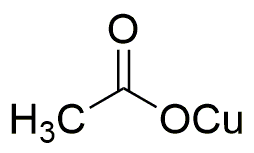Copper(I) acetate is widely utilized in research focused on:
- Catalysis: It serves as an effective catalyst in various organic reactions, enhancing reaction rates and selectivity. This is particularly beneficial in the synthesis of fine chemicals and pharmaceuticals.
- Organic Synthesis: Researchers use it in the preparation of various organic compounds, including those used in dyes and pigments, due to its ability to facilitate coupling reactions.
- Material Science: In the development of conductive polymers and nanomaterials, copper(I) acetate is employed to improve electrical properties, making it valuable in electronics and sensor applications.
- Antimicrobial Applications: Its antimicrobial properties make it useful in coatings and treatments for surfaces that require protection against bacteria and fungi, particularly in healthcare settings.
- Research in Coordination Chemistry: It is a key component in studying coordination compounds, helping researchers understand metal-ligand interactions, which is crucial for developing new materials and catalysts.
General Information
Properties
Safety and Regulations
Applications
Copper(I) acetate is widely utilized in research focused on:
- Catalysis: It serves as an effective catalyst in various organic reactions, enhancing reaction rates and selectivity. This is particularly beneficial in the synthesis of fine chemicals and pharmaceuticals.
- Organic Synthesis: Researchers use it in the preparation of various organic compounds, including those used in dyes and pigments, due to its ability to facilitate coupling reactions.
- Material Science: In the development of conductive polymers and nanomaterials, copper(I) acetate is employed to improve electrical properties, making it valuable in electronics and sensor applications.
- Antimicrobial Applications: Its antimicrobial properties make it useful in coatings and treatments for surfaces that require protection against bacteria and fungi, particularly in healthcare settings.
- Research in Coordination Chemistry: It is a key component in studying coordination compounds, helping researchers understand metal-ligand interactions, which is crucial for developing new materials and catalysts.
Documents
Safety Data Sheets (SDS)
The SDS provides comprehensive safety information on handling, storage, and disposal of the product.
Product Specification (PS)
The PS provides a comprehensive breakdown of the product’s properties, including chemical composition, physical state, purity, and storage requirements. It also details acceptable quality ranges and the product's intended applications.
Certificates of Analysis (COA)
Search for Certificates of Analysis (COA) by entering the products Lot Number. Lot and Batch Numbers can be found on a product’s label following the words ‘Lot’ or ‘Batch’.
*Catalog Number
*Lot Number
Certificates Of Origin (COO)
This COO confirms the country where the product was manufactured, and also details the materials and components used in it and whether it is derived from natural, synthetic, or other specific sources. This certificate may be required for customs, trade, and regulatory compliance.
*Catalog Number
*Lot Number
Safety Data Sheets (SDS)
The SDS provides comprehensive safety information on handling, storage, and disposal of the product.
DownloadProduct Specification (PS)
The PS provides a comprehensive breakdown of the product’s properties, including chemical composition, physical state, purity, and storage requirements. It also details acceptable quality ranges and the product's intended applications.
DownloadCertificates of Analysis (COA)
Search for Certificates of Analysis (COA) by entering the products Lot Number. Lot and Batch Numbers can be found on a product’s label following the words ‘Lot’ or ‘Batch’.
*Catalog Number
*Lot Number
Certificates Of Origin (COO)
This COO confirms the country where the product was manufactured, and also details the materials and components used in it and whether it is derived from natural, synthetic, or other specific sources. This certificate may be required for customs, trade, and regulatory compliance.


